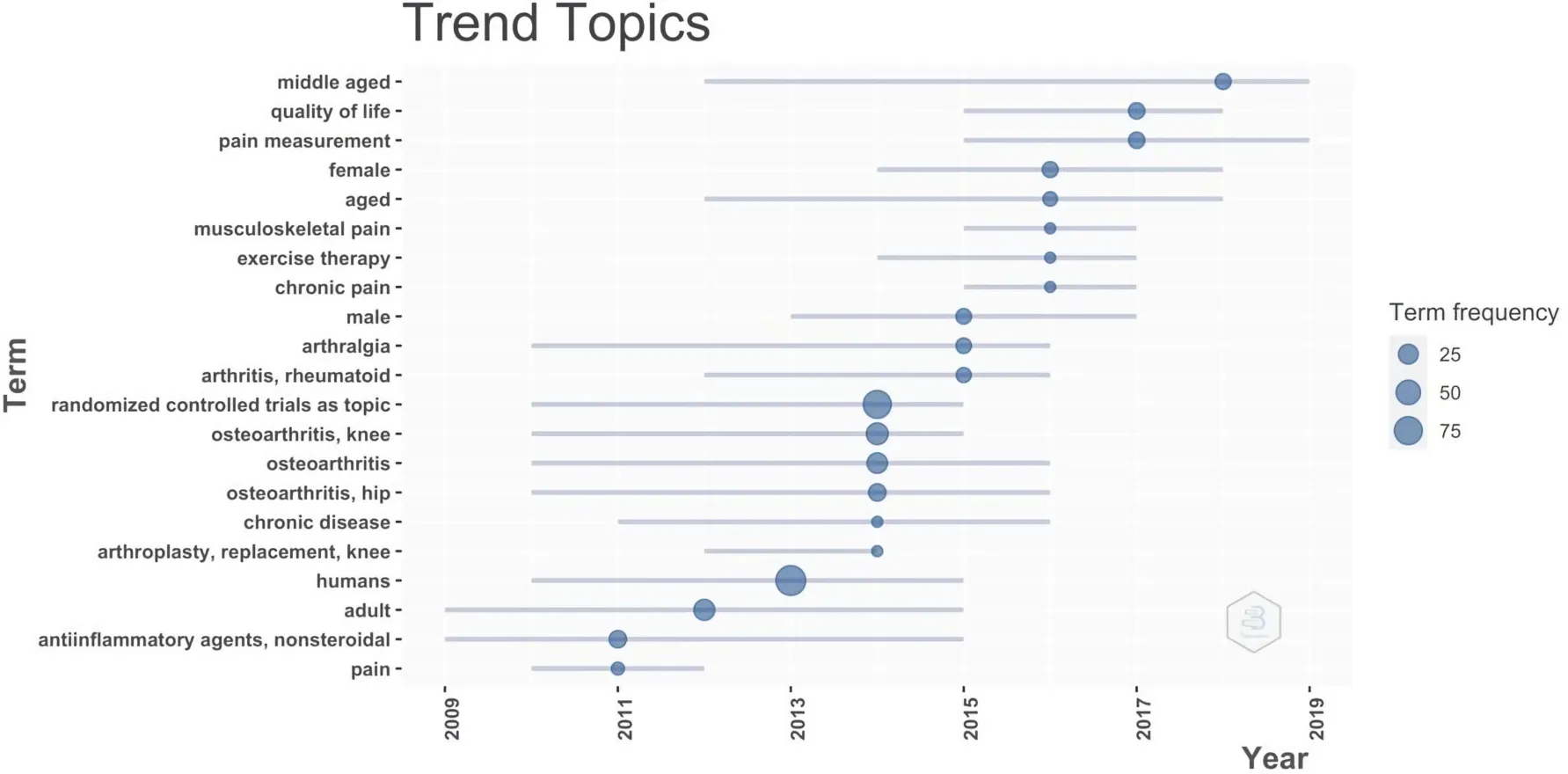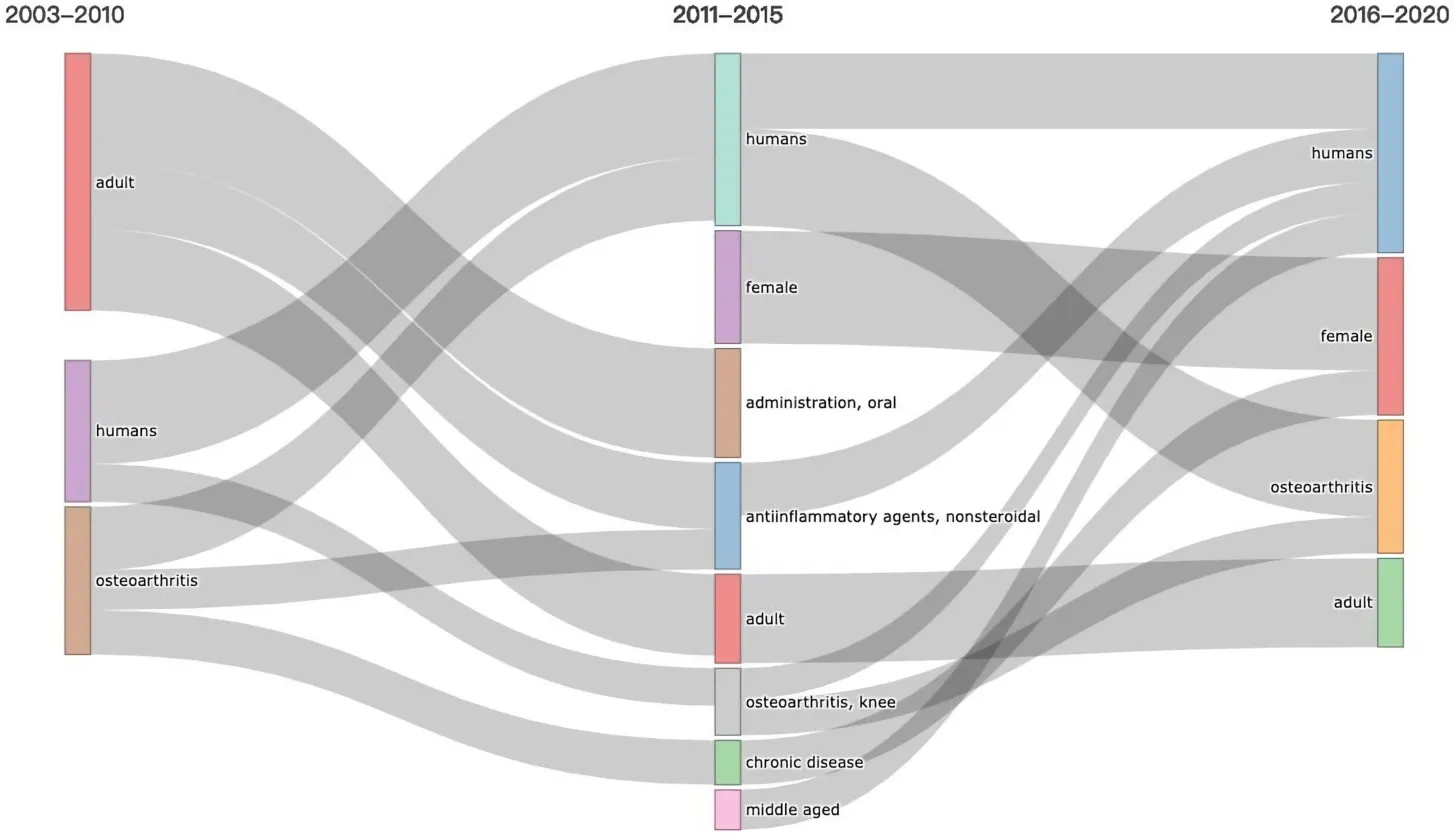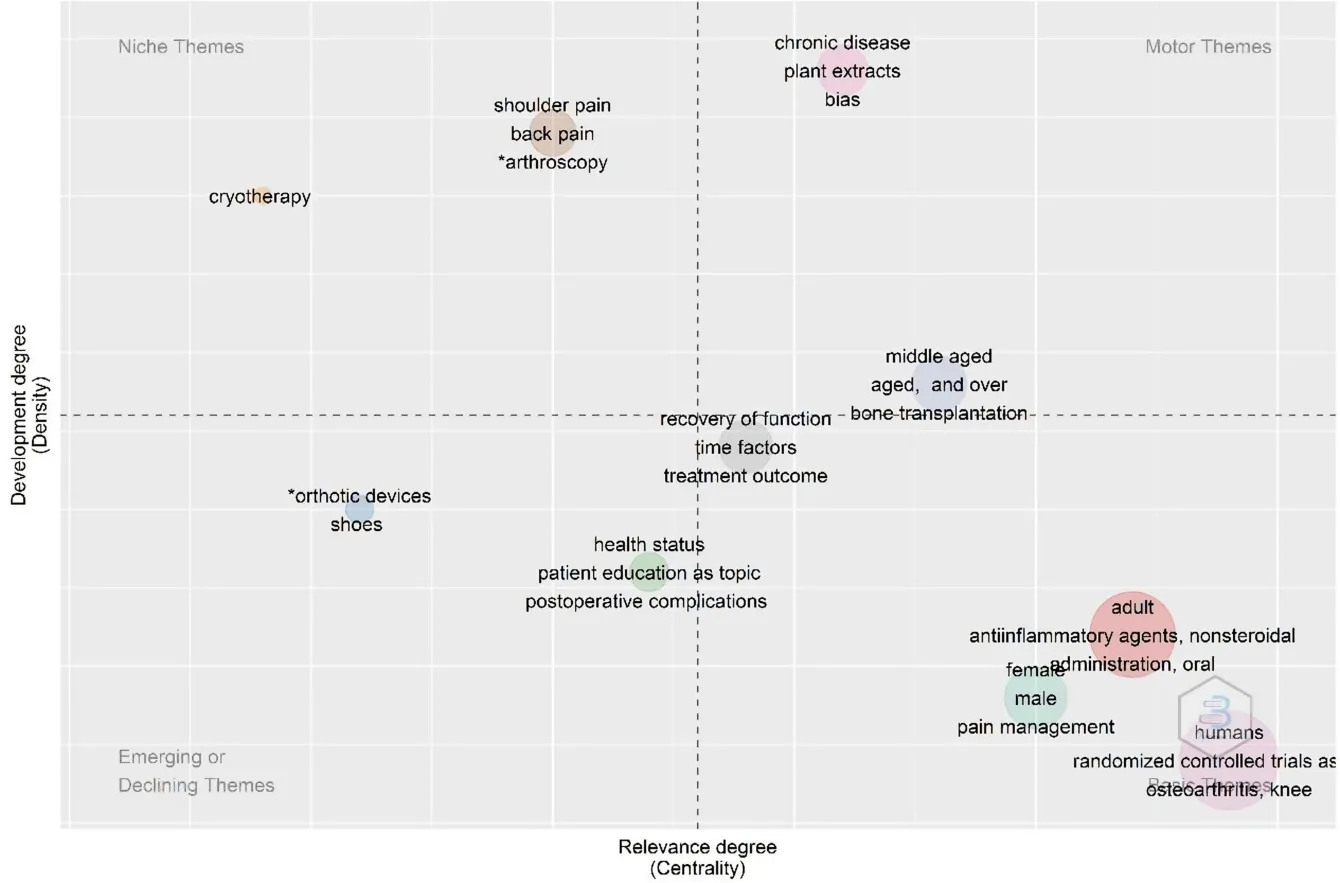Jun-Qing Zhong ,Hui-Lin Zhang ,Xin-Long Ma
1Department of Rehabilitation,Tianjin Hospital,Tianjin,China.2Department of Orthopedics,Tianjin Hospital,Tianjin,China.
Abstract A bibliometric analysis was conducted on reviews on osteoarthritis available in the Cochrane database.Using the Bibliometrix software,93 literature reviews with“osteoarthritis” as a keyword were retrieved.The reviews’ authors,keywords,and citations were visually analyzed to explore the design process and research hotspots of clinical research on osteoarthritis.To our knowledge,this is the first bibliometric analysis of Cochrane review literature on osteoarthritis.The findings of this analysis may help researchers understand the developmental trends in the discipline and guide them in clinical research in the future.
Keywords: bibliometric;review;cochrane;osteoarthritis
Osteoarthritis is the most prevalent form of arthritis and one of the most common orthopedic ailments in the elderly.Approximately one-fourth of individuals over the age of 55 years suffer from knee joint discomfort,with the most frequent symptoms being pain and limitation of daily activities [1].With the increase in the incidence of osteoarthritis in the elderly,the number of researchers investigating osteoarthritis therapeutic strategies is rapidly increasing.Currently,the number of reports on clinical trials on osteoarthritis in PubMed is more than 7,600 and the number has increased remarkably since 2000;owing to the vast body of findings,it is challenging for researchers to understand developmental trends in clinical research on osteoarthritis.
Pritchard,a well-known British information scientist,introduced bibliometrics in 1969.Bibliometrics gained immediate and widespread acceptance as a method of literature visualization.Bibliometrics has been used to conduct extensive studies in various disciplines,such as health care,military and meteorology,among others [2-4].Several bibliometric tools have been used,but some tools have certain shortcomings,such as the need for multiple CiteSpace parameters and the frequent adjustment of the clustering network,which increases the researcher’s workload and leads to researchers spending more time acquiring visually appealing images rather than on data analysis.In addition,CiteSpace also has more significant computer memory requirements than big data,increasing the analysis threshold to an extent.
In this study,we used Bibliometrix(https://www.Bibliometrix.org/),a new bibliometric analysis tool,which is easy to operate,especially for beginners and non-professional researchers and does not require a high computer memory [5].According to the logical workflow preset in Bibliometrix,it is a unique tool developed based on statistical calculation and R language for analysis automation.The Bibliometrix software package imports data from Scopus,Clarivate Analytics’s Web of Science,PubMed,Digital Science Dimensions,and Cochrane databases,performs bibliometric analysis,builds data matrices for co-citation,and coupling,collaborative scientific analysis,and co-word analysis.
In recent years,several reviews on osteoarthritis have been published worldwide;however,to the best of our knowledge;reviews on osteoarthritis have not been analyzed from the perspective of bibliometrics.In this study,Cochrane was used as the data source.Reviews related to osteoarthritis were retrieved,and data were visually analyzed using bibliometric methods to enable the accurate and timely dissemination of information on the current situation and direction of clinical research on osteoarthritis among researchers.This review can be considered a helpful reference for researchers on the bibliographic research foundation for follow-up research work in this field of study.
Literature search
The Cochrane Library website(http://www.cochranelibrary.com)was searched with“Osteoarthritis”as the keyword,without restrictions on time,language,type and topic;the period’s end date was June 10,2022.The selected reviews were saved as plain text.
Import of data
Using the Bibliometrix data packet through R language software,the files obtained from the literature search were imported as“Import raw file (s)”in the data interface.
Data analysis
Ninety-two Cochrane reviews were obtained from the Cochrane Library website with “Osteoarthritis” as the keyword.From 2003 through 2022,8.64 reviews were published yearly,with 342 contributing authors.The average number of co-authors per document was 5.25.The average yearly growth rate of literature was 6.68%,and the number of published reviews did not exhibit a distinct upward or downward trend,with 39 reviews (41.93 percent) published in 2009-2010 and 2014-2015 (Figure 1).Cochrane is a non-profit international organization that was established in 1993.A reliable scientific base for clinical treatment can be provided by acquiring,preserving,disseminating,and updating high-quality evidence in various systematic evaluations in the field of medicine,which may be followed by the promotion of extensive development in evidence-based medicine globally.The database assembles information on the most comprehensive achievements of the best medical research worldwide and is recognized as the “gold standard”in the field of evidence-based health care.It is a high-quality evidence database and a primary source of clinical research evidence.Therefore,in this review,we have summarized osteoarthritis articles obtained from the Cochrane database to help elucidate the research content,focus,and developmental trends of clinical research more comprehensively and systematically.
Because the review is an academic paper that analyzes,refines and sorts relevant data from a specific field or specialty,presents information on the most recent progress,academic opinions,or suggestions and comprehensively introduces and expounds them,the published review is affected by the cumulative effect of time,and then changes like a hump.According to introductory statistics,the peak time for the publication of the following review should be 2020-2022;however,the data do not support this concept.The authors speculate that the global COVID-19 epidemic may be one of the main reasons for the decline in osteoarthritis research.
Author information analysis
Three hundred and forty-two authors contributed to 93 reviews,among which Moore and Derry published the most significant number of reviews (25 articles,26.88%),and the articles fragmented were 3.41 and 3.24 respectively (Table 1).To indicate the relative contributions of various authors to the same document,the authors were split into corresponding coefficients based on their institutions and nations [6].Lastly,the authors’ contributions were quantified.The first systematic review on osteoarthritis was published in 2003 when Brosseau and Welch explored the use of hyperthermia in osteoarthritis [7].Three randomized controlled trials on 179 patients were included in the study.The trial design focused on the comparative analysis of cold therapy and hyperthermia.Significant changes were observed in joint mobility,function,and knee strength after ice compress massage,but the discomfort in patients with osteoarthritis did not differ.However,a hot compress was not found to be beneficial to joint swelling;thus,more standardized programs and participants are required to assess the treatment of knee osteoarthritis by hyperthermia.
Moore published five systematic reviews in 2009,which examined the efficacy of five analgesic drugs (etodolac,lornoxicam,meloxicam,tiaprofenic and nabumetone) after surgery in adults [8-12].Among them,etodolac-based analgesics are smaller than other commonly used analgesics;lornoxicam is effective for moderate and severe postoperative analgesia.No statistically significant difference was observed between adverse reactions and the reactions to the placebo.According to the area calculation of the “pain relief-time” curve,meloxicam and nabumetone have not shown clear evidence in acute postoperative pain and hence,are not recommended as the first option for postoperative analgesia in adults (Figure 2).
Based on the author’s participation in clustering analysis,more green and purple clusters were formed,both of which included more than five people (Figure 3).Moore,Derry,Wells,Rutjes,and others have conducted more studies on osteoarthritis-related concerns based on the number of clusters and the number of published reviews.Among them,Moore and Derry have expounded and analyzed the use of various analgesic drugs after osteoarthritis surgery [8-19].Wells published a review and analytical report on the treatment of osteoarthritis with pharmaceuticals (viscosupplementation and acetaminophen,among others),sports training,and laser [7,20-26].Rutjes published a review and analysis on physical therapy,joint cavity irrigation,and related drugs (tramadol and opioids) in osteoarthritis [26-33].

Figure 1 Distribution of published years of reviews.Since 2009,the review of osteoarthritis has increased significantly,and the number of reviews has shown a“hump” change,but the number has an increasing trend as a whole.

Table 1 The number of articles published by the top 10 authors and the coefficient of articles fractionalized

Figure 2 The volume and time chart of reviews published by the author.The publication of the review focuses on the authors shown in the picture.Among them,Moore,Derry and others published 5 reviews in one year,and Wells published several reviews from 2003 to 2019,reflecting that he has been paying close attention to the related research on osteoarthritis.

Figure 3 Co-Author cluster analysis.The size of the circle represents the number of reviews published in direct proportion,and different colors represent different clusters.For example,Moore and Derry jointly published several reviews related to osteoarthritis.
Keywords and trend analysis
The translation of all keywords into a treemap revealed that “humans(91),randomized controlled trials as a topic (75),and osteoporosis knee(34)”are among the top three keywords.The main content of the review and analysis of osteoarthritis is the randomized controlled trial of human knee osteoarthritis,including the classification of gender(female (12) &male (11)),and the symptoms are arthralgia (11),postoperative pain (9),skeletal muscle pain (6),etc.Interventions included non-steroidal drugs (16),arthritic knee replacement (6),(5),and exercise therapy (5).The observation indicators included quality of life (13),pain (7),range of motion articulation (5) and recovery of function (4),among others.
In terms of the keyword trend analysis,visualization revealed that the three themes of “middle middle-aged,quality of life,and pain measurement” are more visible in trends in recent years (Figure 4).“Middle-aged” appeared for the first time in 2012 and 18 times in 2019,primarily after 2018,which may indicate the rejuvenation of osteoarthritis.“Quality of Life” and “Pain Measurement” appeared for the first time in 2015 and 26 times in all.The frequency of these two terms has increased considerably since 2017,indicating that the treatment of osteoarthritis is not limited to the resolution of symptoms,such as pain and dysfunction,and indicating the necessity for improving patients’ quality of life.Chapman et al.explained the pain measure in 1985 [1].Despite significant advances in pain measurement over decades of research,the quantification of pain remains challenging owing to its complexity,which necessitates interdisciplinary collaboration and communication.Pain measure has received wide attention in recent times,possibly owing to advocacy on pain management in recent years.Individualized analgesia schemes depend on pain measurement and evaluation,and precise and effective pain measurement is critical for designing analgesia schemes.
Thematic evolution uses keywords as evolution themes and chooses several words: 500,min cluster frequency (per thousand docs): 5,weight index: inclusion index weighted by word occurrences;Min Weight index: 0.08.Because of the long period,the results were divided twice from 2003 to 2022 and a visualization map of theme evolution was obtained (Figure 5).As shown in Figure 5,“Humans”and “Adult” are the primary themes throughout,but with time,the theme “Adult” gradually weakens.Women,administration and other issues that are closely connected to the three primary themes-“Adult”,“Humans” and “Osteogenesis”-are defined based on progression from the first stage (2003-2010) to the second stage (2011-2015).In the third stage (2016-2020),knee osteogenesis,“Chronic disease” and“Middle-aged” were both related to “Humans”.The weights of“Female” in the second and third stages was 84.6 and 118,respectively,indicating that an increasing number of scholars are focusing on the correlation between gender and osteoarthritis.The analytical strategy on the thematic map is as follows: 250 words were selected,min cluster frequency (per thousand docs): 5,number of labels (for each cluster): 3,and obtain the thematic map of“osteoarthritis” determined by cluster and co-occurrence network from 2003 to 2022 (Figure 6).The X-axis denotes centrality (the degree of interaction between a network cluster and other clusters).In contrast,the Y-axis denotes density(a measure of the internal strength of the cluster network).The first quadrant determines the sports theme (i.e.,an important theme that develops well for building a research field).The second quadrant represents Niche Themes (topics of little importance in this field).The third quadrant represents emerging or declining themes (weaker development and marginal themes).The fourth quadrant represents the basic theme (spanning different research areas in this field).The fourth quadrant represents the key subjects associated with osteoarthritis,such as a randomized controlled trial,humans,knee osteoarthritis,and so on(Figure 6).The light green circle is placed between the third and fourth quadrants,and“Middle Middle-Aged”appears 12 times in all,consistent with the keyword pattern in Figure 6 as a new topic.
Owing to the lack of extensive reference information in the Cochrane database,each published report was manually noted,and the reference information was evaluated.The 93 reviews were cited 3,620 times,with an average of 39.35 times,among which the reviews written by Liu and Latham in 2009 were cited 298 times,ranking first[34].The authors combined pertinent data from several databases and 6,700 individuals were included in the study.Among them,503 patients with osteoarthritis (SMD -0.30,95% CI -0.48 to -0.13)reported pain relief after progressive resistance strength training(PRT).Reportedly,progressive resistance training was an effective intervention,especially for improving the strength and exercise ability of the elderly.The top 10 reviews were cited 1,530 times (42.27%),including four articles related to functional exercise,four articles related to drugs and two articles related to surgery and acupuncture treatment (Table 2) [20,21,23,34-40].Based on the number of citations,functional exercise piqued the interest of many researchers for intervention therapies for osteoarthritis.Compared to medications or surgical therapy,functional exercise is more natural and widely accepted.
The intervention measures from 93 osteoarthritis reviews in the Cochrane database were examined and categorized individually(Table 3): (1) drug;(2) operation;(3) physiotherapy;(4) exercise therapy;(5)health education;(6)traditional Chinese medicine(TCM);(7) orthotopic treatment.The drug accounted for the highest proportion in all categories (approximately 40.8% (38/93)),indicating that the treatment of osteoarthritis primarily focuses on drug therapy,followed by surgical treatment;however,it was gratifying that non-drug non-surgical treatments,such as physiotherapy,exercise therapy and health education,accounted for 29.03% (27/93);a document of functional equivalence is included for these.Furthermore,most researchers focused on the treatment of osteoarthritis with TCM.Five reviews related to TCM,including acupuncture treatment,accounted for three articles.Meanwhile,Eric Manheimer reported a contradictory finding on the final clinical effect of acupuncture treatment in two articles [40,41].Acupuncture therapy in osteoarthritis has been contentious in academic circles,possibly owing to difficulties in standardizing trial design and operation and differences in how researchers would interpret TCM theory.However,with the global dissemination of TCM,rigorous and scientific experimental design in future studies will indeed indicate the therapeutic effect of TCM.

Figure 4 Analysis of trend topics.We selected keywords as the theme for trend analysis and found that“Middle aged”was at the forefront of the trend,suggesting that the rejuvenation of osteoarthritis is the focus of attention in recent years.

Figure 5 Analysis of theme evolution.We divided the time span into three periods (2003-2020) to observe the evolution trend of the theme in more detail,in which“Female”and“Middle aged”gradually evolved in the past 10 years,suggesting that more and more attention has been paid to gender and youth such as osteoarthritis.

Figure 6 Thematic map of osteoarthritis.Thematic map is divided into four quadrants,each of which represents a different meaning.The first quadrant is Motor Themes,the second quadrant is Niche Themes,the third quadrant is Emerging or Declining Themes,the fourth quadrant is Basis Themes,image,the X axis is Centrality,which indicates the degree of interaction between the network cluster and other clusters,and the Y axis is Density,which measures the internal strength of the cluster network.

Table 2 Citation analysis of the top 10 reviews
Through the analysis of 93 systematic reviews,it was found that the young age and gender differences in osteoarthritis may be one of the hot spots worth attention to and research in the future.Secondly,the exercise of osteoarthritis is the most frequently cited literature among all intervention methods,among which PRT was cited 298 times,which also suggests that non-drug and non-surgical treatment of osteoarthritis has become one of the hot spots of future research.Although acupuncture in the treatment of osteoarthritis is still controversial,it occupies an important position as a complementary and alternative medical intervention in addition to exercise.With the acceleration of the internationalization of TCM,acupuncture may become one of the important ways of osteoarthritis intervention.
However,this study has some limitations,possibly owing to the insufficient data obtained from the Cochrane database.First,the database lacked information on the author’s institutions and country.Second,the journals could not be compared and analyzed because the literature was collected from the Cochrane database.In conclusion,this study adopted an online bibliometric method based on R to visually analyze review literature in the Cochrane database.This was a unique attempt to analyze the overall development of a discipline from a comprehensive perspective.Our findings may help researchers gain knowledge on the developmental trends in this discipline and aid clinical research in the future.
In this rapid information technology development period,the quantity of academic publications is rapidly increasing,thus rendering theconventional method of reading literature challenging.The use of bibliometric visualization for understanding a specific topic is gaining rapid popularity.This review on osteoarthritis research primarily focused on intervention measures,including drugs,functional exercise,surgery and physical therapy,among others,with functional exercise being the intervention mode that piqued the interest of most researchers.In addition,the rejuvenation of osteoarthritis and the evaluation of pain were also the focus of investigations by many researchers.

Table 3 Cluster table of intervention style